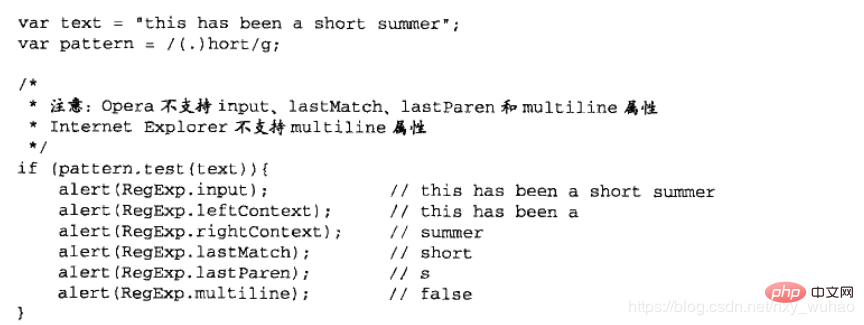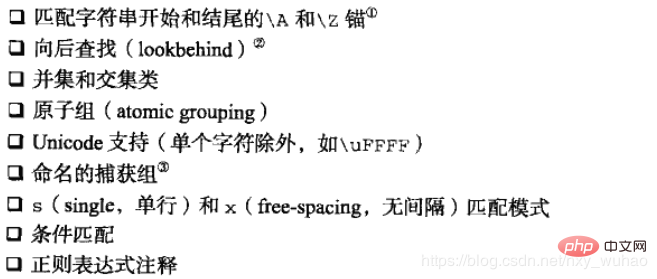How to use regular expressions in javascript?

This section talks about the use of regular expressions in js. Note that the regular object is a reference type.
Initialization: Use of literals and objects
Like the definition of objects, we can use literals to define regular expressions, or we can use regular objects to define regular expressions. The difference between them is There are some differences in the escaping used.
When using literals, use / / to wrap the regular expression. You can write the matching pattern or not. If not, the default is not global matching. When we use it, we usually use Literal initialization, because it is simpler, and escaping is not as complicated as strings.
// 正则表达式 /at/g 表示匹配所有at /g表示全局搜索
var pattern1 = /at/g; // 注意不用字符串
var pattern2 = RegExp('/at', 'g');The following need to be escaped:
Attributes of regular objects
Since the attributes of regular objects can be seen in literal variables, so These methods are not very useful, just know them: 
exec() method (capture method)
The execution result of the exec method is not all matching items, but The return value of the first matched item is as shown in the following code (about the concept of capturing group, we will use it later. Here we know that only one will be matched at a time, and it will be returned at the 0th position of the array)
// exec的返回值 var text = 'mom and dad and baby'; var pattern = /mom( and dad( and baby)?)?/gi; var matches = pattern.exec(text); alert(matches.index); // 0 // 拥有index属性标识匹配项再字符串中的位置 alert(matches.input); // mom and dad and baby // 标识原字符串 alert(matches[0]); //mom and dad // 标识匹配的字符串 alert(matches[1]); //and dad //捕获组匹配的字符串 alert(matches[2]); //and baby
The exec method should pay attention to the impact of the global flag /g on the execution results. When /g is not written, there is no global matching. Each execution starts from the beginning. If /g is written, the matching is global. The next match will continue based on the previous one. This situation can be explained by looking at the example below
// 不写/g 每一次都是从头开始匹配 var text = 'cat, bat, sat, fat'; var pattern1 = /.at/; var matches = pattern1.exec(text); alert(matches.index); //0 alert(matches[0]); //cat alert(pattern1.lastIndex); //0 //lastIndex方法是问题的关键,注意它是pattern1对象的属性,其实就记录了这个正则匹配到哪个位置了,这里都是0说明是一直从零开始匹配 matches = pattern1.exec(text); alert(matches.index); //0 alert(matches[0]); //cat alert(pattern1.lastIndex); //0
Add /g and let’s see how the results change
var text = 'cat, bat, sat, fat'; var pattern1 = /.at/g; var matches = pattern1.exec(text); alert(matches.index); //0 alert(matches[0]); //cat alert(pattern1.lastIndex); //3 //lastIndex标识经过了这次匹配,下次匹配应该从什么位置开始进行 matches = pattern1.exec(text); alert(matches.index); //5 // 标识匹配到的位置 alert(matches[0]); //bat alert(pattern1.lastIndex); //8
test method
The test method is used to return true false after matching. If you only want to know whether there is a match and don't want to know the specific results, use this. Often used in if statements to determine whether user input is valid, etc.
var text = '000-00-0000';
var pattern = /\d{3}-\d{2}-\d{4}/;
if (pattern.test(text)) {
alert('matched'); //matched
}Global attributes
Through the properties of RegExp, we can get some global regular information, such as what string was input just matched and what information was matched last time. This is a bit like global Static variables, let’s see what information global attributes support. 
Note that global attributes can be obtained using both long and short attribute names. Let’s take a look at the use of long and short attributes


Unsupported functions

Related tutorial recommendations: JavaScript video tutorial
The above is the detailed content of How to use regular expressions in javascript?. For more information, please follow other related articles on the PHP Chinese website!

Hot AI Tools

Undresser.AI Undress
AI-powered app for creating realistic nude photos

AI Clothes Remover
Online AI tool for removing clothes from photos.

Undress AI Tool
Undress images for free

Clothoff.io
AI clothes remover

AI Hentai Generator
Generate AI Hentai for free.

Hot Article

Hot Tools

Notepad++7.3.1
Easy-to-use and free code editor

SublimeText3 Chinese version
Chinese version, very easy to use

Zend Studio 13.0.1
Powerful PHP integrated development environment

Dreamweaver CS6
Visual web development tools

SublimeText3 Mac version
God-level code editing software (SublimeText3)

Hot Topics
 How to use Baidu advanced search
Feb 22, 2024 am 11:09 AM
How to use Baidu advanced search
Feb 22, 2024 am 11:09 AM
How to use Baidu Advanced Search Baidu search engine is currently one of the most commonly used search engines in China. It provides a wealth of search functions, one of which is advanced search. Advanced search can help users search for the information they need more accurately and improve search efficiency. So, how to use Baidu advanced search? The first step is to open the Baidu search engine homepage. First, we need to open Baidu’s official website, which is www.baidu.com. This is the entrance to Baidu search. In the second step, click the Advanced Search button. On the right side of the Baidu search box, there is
 PHP regular expression validation: number format detection
Mar 21, 2024 am 09:45 AM
PHP regular expression validation: number format detection
Mar 21, 2024 am 09:45 AM
PHP regular expression verification: Number format detection When writing PHP programs, it is often necessary to verify the data entered by the user. One of the common verifications is to check whether the data conforms to the specified number format. In PHP, you can use regular expressions to achieve this kind of validation. This article will introduce how to use PHP regular expressions to verify number formats and provide specific code examples. First, let’s look at common number format validation requirements: Integers: only contain numbers 0-9, can start with a plus or minus sign, and do not contain decimal points. floating point
 How to validate email address in Golang using regular expression?
May 31, 2024 pm 01:04 PM
How to validate email address in Golang using regular expression?
May 31, 2024 pm 01:04 PM
To validate email addresses in Golang using regular expressions, follow these steps: Use regexp.MustCompile to create a regular expression pattern that matches valid email address formats. Use the MatchString function to check whether a string matches a pattern. This pattern covers most valid email address formats, including: Local usernames can contain letters, numbers, and special characters: !.#$%&'*+/=?^_{|}~-`Domain names must contain at least One letter, followed by letters, numbers, or hyphens. The top-level domain (TLD) cannot be longer than 63 characters.
 PHP regular expressions: exact matching and exclusion of fuzzy inclusions
Feb 28, 2024 pm 01:03 PM
PHP regular expressions: exact matching and exclusion of fuzzy inclusions
Feb 28, 2024 pm 01:03 PM
PHP Regular Expressions: Exact Matching and Exclusion Fuzzy inclusion regular expressions are a powerful text matching tool that can help programmers perform efficient search, replacement and filtering when processing text. In PHP, regular expressions are also widely used in string processing and data matching. This article will focus on how to perform exact matching and exclude fuzzy inclusion operations in PHP, and will illustrate it with specific code examples. Exact match Exact match means matching only strings that meet the exact condition, not any variations or extra words.
 Simple JavaScript Tutorial: How to Get HTTP Status Code
Jan 05, 2024 pm 06:08 PM
Simple JavaScript Tutorial: How to Get HTTP Status Code
Jan 05, 2024 pm 06:08 PM
JavaScript tutorial: How to get HTTP status code, specific code examples are required. Preface: In web development, data interaction with the server is often involved. When communicating with the server, we often need to obtain the returned HTTP status code to determine whether the operation is successful, and perform corresponding processing based on different status codes. This article will teach you how to use JavaScript to obtain HTTP status codes and provide some practical code examples. Using XMLHttpRequest
 How to match timestamps using regular expressions in Go?
Jun 02, 2024 am 09:00 AM
How to match timestamps using regular expressions in Go?
Jun 02, 2024 am 09:00 AM
In Go, you can use regular expressions to match timestamps: compile a regular expression string, such as the one used to match ISO8601 timestamps: ^\d{4}-\d{2}-\d{2}T \d{2}:\d{2}:\d{2}(\.\d+)?(Z|[+-][0-9]{2}:[0-9]{2})$ . Use the regexp.MatchString function to check if a string matches a regular expression.
 How to get HTTP status code in JavaScript the easy way
Jan 05, 2024 pm 01:37 PM
How to get HTTP status code in JavaScript the easy way
Jan 05, 2024 pm 01:37 PM
Introduction to the method of obtaining HTTP status code in JavaScript: In front-end development, we often need to deal with the interaction with the back-end interface, and HTTP status code is a very important part of it. Understanding and obtaining HTTP status codes helps us better handle the data returned by the interface. This article will introduce how to use JavaScript to obtain HTTP status codes and provide specific code examples. 1. What is HTTP status code? HTTP status code means that when the browser initiates a request to the server, the service
 How to verify password using regular expression in Go?
Jun 02, 2024 pm 07:31 PM
How to verify password using regular expression in Go?
Jun 02, 2024 pm 07:31 PM
The method of using regular expressions to verify passwords in Go is as follows: Define a regular expression pattern that meets the minimum password requirements: at least 8 characters, including lowercase letters, uppercase letters, numbers, and special characters. Compile regular expression patterns using the MustCompile function from the regexp package. Use the MatchString method to test whether the input string matches a regular expression pattern.






